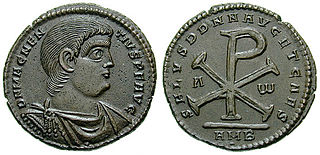The 420s decade ran from January 1, 420, to December 31, 429.

Year 417 (CDXVII) was a common year starting on Monday of the Julian calendar. At the time, it was known as the Year of the Consulship of Honorius and Constantius. The denomination 417 for this year has been used since the early medieval period, when the Anno Domini calendar era became the prevalent method in Europe for naming years.
The 350s decade ran from January 1, 350, to December 31, 359.
Year 356 (CCCLVI) was a leap year starting on Monday of the Julian calendar. At the time, it was known as the Year of the Consulship of Constantius and Iulianus. The denomination 356 for this year has been used since the early medieval period, when the Anno Domini calendar era became the prevalent method in Europe for naming years.
The 290s decade ran from January 1, 290, to December 31, 299.

Year 300 (CCC) was a leap year starting on Monday of the Julian calendar. At the time, it was known as the Year of the Consulship of Constantius and Valerius. The denomination 300 for this year has been used since the early Middle Ages / Medieval period, when the Latin language term / abbreviation "Anno Domini" for the calendar era became the prevalent universal / worldwide method for naming and numbering years. First beginning in Europe at the end of the Roman Empire (after the split of the Western Roman Empire and Eastern Roman Empire in the early Middle Ages / Medieval period.

Year 355 (CCCLV) was a common year starting on Sunday of the Julian calendar. At the time, it was known as the Year of the Consulship of Arbitio and Maesius. The denomination 355 for this year has been used since the early medieval period, when the Anno Domini calendar era became the prevalent method in Europe for naming years.

Year 293 (CCXCIII) was a common year starting on Sunday of the Julian calendar. In the Roman Empire, it was known as the Year of the Consulship of Diocletian and Maximian. The denomination 293 for this year has been used since the early medieval period, when the Anno Domini calendar era became the prevalent method in Europe for naming years.

Year 326 (CCCXXVI) was a common year starting on Saturday of the Julian calendar. At the time, it was known as the Year of the Consulship of Constantinus and Constantinus. The denomination 326 for this year has been used since the early medieval period, when the Anno Domini calendar era became the prevalent method in Europe for naming years.

Year 306 (CCCVI) was a common year starting on Tuesday of the Julian calendar. At the time, it was known as the Year of the Consulship of Constantius and Valerius. The denomination 306 for this year has been used since the early medieval period, when the Anno Domini calendar era became the prevalent method in Europe for naming years.

Year 357 (CCCLVII) was a common year starting on Wednesday of the Julian calendar. At the time, it was known as the Year of the Consulship of Constantius and Iulianus. The denomination 357 for this year has been used since the early medieval period, when the Anno Domini calendar era became the prevalent method in Europe for naming years.
Year 353 (CCCLIII) was a common year starting on Friday of the Julian calendar. At the time, it was known as the Year of the Consulship of Magnentius and Decentius. The denomination 353 for this year has been used since the early medieval period, when the Anno Domini calendar era became the prevalent method in Europe for naming years.
Year 352 (CCCLII) was a leap year starting on Wednesday of the Julian calendar. At the time, it was known as the Year of the Consulship of Decentius and Paulus. The denomination 352 for this year has been used since the early medieval period, when the Anno Domini calendar era became the prevalent method in Europe for naming years.

Year 351 (CCCLI) was a common year starting on Tuesday of the Julian calendar. At the time, it was known in Rome as the Year of the Consulship of Magnentius and Gaiso. The denomination 351 for this year has been used since the early medieval period, when the Anno Domini calendar era became the prevalent method in Europe for naming years.

Year 350 (CCCL) was a common year starting on Monday of the Julian calendar. At the time, it was known as the Year of the Consulship of Sergius and Nigrinianus. The denomination 350 for this year has been used since the early medieval period, when the Anno Domini calendar era became the prevalent method in Europe for naming years.
Year 343 (CCCXLIII) was a common year starting on Saturday of the Julian calendar. At the time, it was known as the Year of the Consulship of Memmius and Romulus. The denomination 343 for this year has been used since the early medieval period, when the Anno Domini calendar era became the prevalent method in Europe for naming years.

Year 337 (CCCXXXVII) was a common year starting on Saturday of the Julian calendar. At the time, it was known as the Year of the Consulship of Felicianus and Titianus. The denomination 337 for this year has been used since the early medieval period, when the Anno Domini calendar era became the prevalent method in Europe for naming years.

Flavius Claudius Constantius Gallus was a statesman and ruler in the eastern provinces of the Roman Empire from 351 to 354, as Caesar under emperor Constantius II, his cousin. A grandson of emperor Constantius Chlorus and empress Flavia Maximiana Theodora, and a son of Julius Constantius and Galla, he belonged to the Constantinian dynasty. Born during the reign of his uncle Constantine the Great, he was among the few male members of the imperial family to survive the purge that followed Constantine's death. Under Constantius II, Gallus served as deputy emperor, based in Antioch and married to Constantius' sister Constantina. He dealt with a Jewish revolt in the years 351-352. Gallus ultimately fell out of favor with Constantius and was executed, being replaced as Caesar by his younger half-brother Julian.

Flavia Valeria Constantina, later known as Saint Constance, was the eldest daughter of Roman emperor Constantine the Great and his second wife Fausta, daughter of Emperor Maximian. Constantina may have received the title of Augusta from her father, and is venerated as a saint, having developed a medieval legend wildly at variance with what is known of her actual character.

Year 420 (CDXX) was a leap year starting on Thursday of the Julian calendar. At the time, it was known as the Year of the Consulship of Theodosius and Constantius. The denomination 420 for this year has been used since the early medieval period, when the Anno Domini calendar era became the prevalent method in Europe for naming years.













